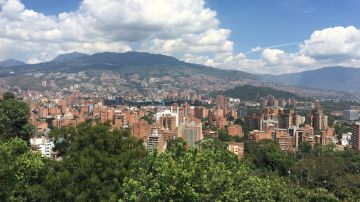From Narcos to Nightlife: Medellín is Undergoing a Cultural Resurgence You Don’t Want to Miss
Driving through the streets in almost any neighborhood of Medellín, Colombia my Uber driver would sometimes worry seeing me holding my iPhone in plain sight with the window open

Photo: Bill O'Connor
Driving through the streets in almost any neighborhood of Medellín, Colombia my Uber driver would sometimes worry seeing me holding my iPhone in plain sight with the window open. I didn’t quite get it until an older driver explained that you never know when a thief might stealthily pass by and grab the phone. I had walked around very late at night, feeling totally safe with the screen back light glowing and clearly visible to strangers walking past. In the posh, nightlife-heavy neighborhoods of the city, I sometimes felt like I could have been in Miami. Weren’t the Uber drivers in the same Medellín that I was?
The answer became clear — they weren’t. The Medellín of just 20 or 30 years ago was the Medellín dominated by narcotraficantes rather than nightlife. But by 2015, the Escobar-era deadly murder rates had reduced ten-fold and police have been able to maintain a strong grip on curtailing the remaining drug-related crime. Here’s how the city has reinvented itself as a model metropolis for the rest of Latin America — and why you shouldn’t be afraid to add it to your travel bucket list.
Education
Sergio Fajardo—the mayor of Medellín from 2004-2007—made it his goal to make Medellín the most educated city in Colombia. He followed the examples of Spain, Chile, and Singapore on how to strengthen the economy by investing in education. The innovation focused non-profit, Ruta N, has helped to increase government expenditures in education, which has translated to the creation of thousands of high-paying jobs. Next study abroad destination, anyone?wp_*posts
Infrastructure
You may often think of cable cars when you want to hit the slopes, but in Medellín they serve as an integral part of the city’s public transit system. As mayor, Fajardo focused on infrastructure —public utilities, city planning, and the creation of a distinct paisa architecture—in addition to education. Medellín became the first city in the world to make this type of transit part of its public network when it launched in 2004. Linking the outer elevated regions of Medellín that were previously inaccessible to the city center, the cars have helped to bring the slums in the Santo Domingo neighborhood out of the drug days of the past. While these hidden hilly areas were once a central part of Pablo Escobar’s cartel network, the cable car journey has become the top TripAdvisor attraction in Medellín. The network is a symbol of the city’s resurgence in itself. Nowadays, the only thing you’ll have to worry about in this sky high neighborhoods is your stomach being too full after a hearty serving of bandeja paisa.wp_*posts
Fashion & Entertainment
The crackdown on the narcos has allowed new industries to flourish. Goodbye drug lords, hello designers. Companies like Vogue and Marie Claire have finally been able to secure Colombia’s spot on the international fashion map with events like the Colombiamoda trade show in Medellín. You’ll be all set with options to hit Medellín’s hip nightlife scene — from Parque Lleras in the south of the city to the northern neighborhoods where you can find more salsa and reggaeton.wp_*posts
Arts
As a part of the city’s new infrastructure, Medellín is also experiencing a renaissance in the arts. Libraries and cultural centers are cropping up in all corners of the city. Recent films like Los Nadie depict Colombia’s coming-of-age generation in the post narcos era. The lower and middle class twentysomethings in this film spend a lot of their time in the same Santo Domingo slums where Pablo Escobar’s drug-driven Medellín once thrived. Their challenges are a larger representation of all of Medellín —the journey to find their place in the city’s ever-evolving landscape.

















